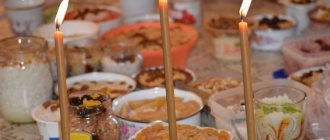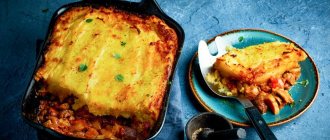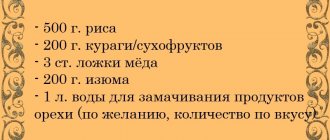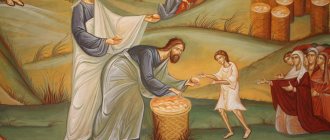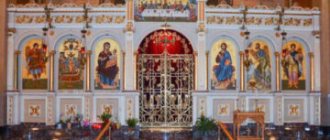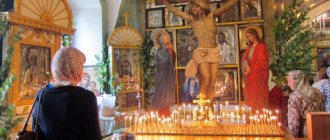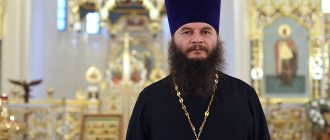"Save me, God!".
Thank you for visiting our website, before you start studying the information, please subscribe to our Orthodox community on Instagram, Lord, Save and Preserve † - https://www.instagram.com/spasi.gospodi/. The community has more than 60,000 subscribers. There are many of us like-minded people and we are growing quickly, we post prayers, sayings of saints, prayer requests, and timely post useful information about holidays and Orthodox events... Subscribe. Guardian Angel to you!
Very often in an Orthodox church, next to a tetrapod (candlestick for commemorating the dead) there are various food items on the table. These products are nothing more than remembrances of deceased loved ones. This ritual is also called a memorial service. This is a funeral service. It consists of prayerful remembrance of the departed. During the reading of the requiem, the priest focuses his attention on the fact that the souls of the departed ascend from the earth to the Judgment to the Face of God. The memorial service is held right next to the memorial table.
The way the world works is that sooner or later we lose a loved one, and so that he can find peace and tranquility in another world, according to church traditions, a memorial service must be ordered in the church. This is a service at which the priest reads prayers for the repose of the soul of the deceased. It is believed that such prayers help to quickly find peace. When such a service is ordered, it is customary to carry a certain set of products, as a donation for the service, which is placed on a special memorial table. We will consider below what products should be for a funeral table.
Funeral table in the church
Each temple has a special place for brought food, which is left before the service. The memorial table, as a rule, is located near the tetrapod on which candles are placed in memory of the deceased.
Lighting candles for the dead is a custom that comes from the pre-Christian period, when lamps illuminated the tabernacle during the time of the prophet Moses. Light is the guidance of the Holy Spirit and symbolizes the Law of God. For Christians, Jesus is the Light Not Made by Hands, He came to lead humanity out of darkness.
The funeral table in the temple is located next to the eve, where candles are lit for the repose
At first, a candle was lit at the beginning of the service before the reading of the Gospels, then all the candles were ignited. Nowadays in Orthodoxy there is a custom of placing and lighting candles in front of icons, during prayer addresses, on graves and in front of portraits of the deceased.
A candle is a symbol of prayer, light reaches out to the Creator, and pure wax symbolizes repentance and the acquisition of purity. One should approach the eve with love and forgiveness for the person in whose name the candle is lit; the payment for it has become a voluntary donation; faith and worship are manifested in him.
After the service, the service for the repose of the dead begins, during which the deceased are remembered. At the same time, the priest emphasizes that we will all appear before the judgment of God.
Advice! If you are not a frequent visitor to the temple, then it is better to go to the church shop or the people helping in the temple and check the location of the eve - a lamp with candles for the repose of the soul and a memorial corner.
Each temple has its own traditions and corner for remembrance. All brought food is laid out in a special place before the start of the service, so that during the funeral service the priest will bless the donations and sprinkle them with holy water.
What does our remembrance “On Repose” mean in notes about the deceased?
The prayer “For the repose” of the dead, as well as the petition for the health of the living, means a prayer for the salvation of the souls of those whose names are pronounced. The prudent thief asked from the cross: “Remember me, Lord, when You come into Your Kingdom!” In response to this request for remembrance, the Lord Jesus proclaims: “Truly I say to you, today you will be with Me in Paradise” (Luke 23:42.43). Consequently, to be remembered by the Lord is the same as “to be in paradise”; it means to have existence in eternal memory, in other words, to gain Eternal Life.
While taking out particles in memory of all the dead, the priest also takes out particles for everyone whose names are mentioned in the submitted memorials or notes “On the repose”. These removed particles do not have a sanctifying or cleansing effect, and they are not given to believers for communion. After all the communicants have partaken of the Holy Mysteries, the deacon will lower these particles into the chalice - so that the deceased, whose names are indicated in notes or memorials, having been washed by the Most Pure Blood of the Son of God, receive Eternal Life. This is also evidenced by the words of the prayer pronounced at the same time: “Wash away, O Lord, the sins of those remembered here, with Your Honest Blood.”
The commemoration of the dead also occurs in the second part of the Liturgy, after the reading of the Gospel, when, during the litany for the dead, the deacon calls on those present to pray for the repose of the souls of the servants of God, whom he calls by name, so that God would forgive them every sin, voluntary and involuntary, and to place their souls where the righteous rest.
At this time, each of the worshipers remembers all the deceased close to his heart and mentally says three times in response to every appeal of the deacon: “Lord, have mercy,” praying diligently both for his own and for all deceased Christians.
“We ask for the mercy of God,” exclaims the deacon, “for the Kingdom of Heaven and the remission of their sins from Christ the Immortal King and our God.”
Those praying in the temple cry out along with the choir: “Give, Lord.”
At this time, the clergyman prays in the altar before the Throne of the Lord, so that He who trampled death and gave life would rest the souls of His departed servants in a brighter place, in a greener place, and forgive them all their sins, “for He is the only one besides sin, His righteousness is righteousness forever and ever.” His word is truth." The priest ends this prayer with the exclamation: “For You are the resurrection and the life,” to which the choir responds in the affirmative: “Amen.”
The priest offers another prayer for the departed after the consecration of the Holy Gifts. The priest prays for all the departed, propitiating God during the sacrifice, and asks all those who have died, in the hope of the Resurrection of the Eternal Life, to rest in the depths of Eternal Bliss.
Saint Athanasius the Great, when asked what the souls of the departed feel when they are remembered, answered: “They partake of a certain benefit from a bloodless sacrifice and charity that is done in memory of them, they partake in the way that the owner of the living and the dead himself knows and commands. Our Lord and God."
Saint Simeon of Thessalonica writes: “Let it be known to every believer that if he loves a relative who has departed from here, then he can obtain great benefits for him if he makes sacrifices for him: giving to the poor, redeeming the captives and performing other deeds of mercy with which God is pleased, he becomes an intercessor for the sublime bliss of the deceased. In particular, one should try to make a bloodless sacrifice for him. because the particle removed in remembrance of the deceased and united with the blood of this sacrifice unites the person remembered with God, invisibly makes him a partaker of the all-cleansing blood of the Redeemer and makes him a fellow member of Christ. Therefore, not only those who benefit from this sacrifice, that is, the brethren who died in peace and repentance, are consoled and saved, but also the sacred Divine souls of the saints find in them and for them a new greatest joy; uniting and communicating with Christ through this Most Sacred Sacrifice, they again triumph in His victory over sin, and more purely and brightly and sincerely partake of His gifts, and implore Him for them. That is why Christ established this sacrifice, and that is why he gave it up for the sanctification and salvation of all, so that they would be one with Him, as He Himself prayed for it. Therefore, the saints constantly pray both for those who remember the dead, and for those who, remembering them, at the same time make a sacred sacrifice in honor and memory of the saints - and thus for all and for all of us they are intercessors and prayer books, asking for mercy so that everyone can achieve a similar fellowship with Christ. From here it is clear that we must remember our departed brethren as diligently as possible so that they, triumphant in Christ, may be granted the grace to be intercessors for us before Him, so that we too may be saved by the prayers of His saints.”
What foods are brought to the funeral table?
Products left on the funeral table for mercy must be aesthetically packaged:
- bread and bakery products purchased or made at home are placed in bags;
- sugar, cereals and flour should also be packaged so that the package does not tear;
- vegetable oil should be tightly closed in the container if it is not packaged in a standard bottle;
- It is advisable to pack sweets and cookies separately;
- vegetables and fruits must be the best, selected;
- wine for communion.
It is prohibited to bring fresh eggs, dairy products, meat and fish to church. Eggs, Easter cakes and Easter cakes are allowed to be brought only on Radonitsa, the 9th day after the Resurrection of the Lord. To avoid getting into trouble, on the eve of the funeral service it is better to go to the temple and check the list of products.
The range of products depends on church holidays and fasts
In addition to food, a note with the name of the deceased, candles purchased from a church store, and oils are left on the funeral table.
Food brought to church without a prayer request has no spiritual meaning; it may feed a homeless person, but it will not help the deceased in any way. Prayer, prayer and faith have power in the hereafter. To achieve the Kingdom of Heaven, you need to put in spiritual work and alms, in this case it is food placed on the table of remembrance.
About the afterlife fate of the dead:
- What happens to the soul 40 days after death
- Ordeals of the soul: what happens after death
Food brought with repentance will help the evil one become more frank, the cruel one more merciful, and the callous soul more kind. Funeral grace has great meaning for the living, it contains repentance, forgiveness and kindness that can be shared with the dead in the spirit world.
By bringing food to the temple, we demonstrate in mercy not so much memory of the deceased person, but rather love and forgiveness for the deceased. After the funeral service, the food is given to the clergy, those who help in the church, and also to the poor and needy who are in or near the church.
What is a memorial service?
This is a special worship service held at:
- days 9 and 40;
- anniversary.
What do they order in the church on the anniversary of death? This is what they are asking to do on this date. This must be done precisely on the day of death. The clergyman will read prayers so that the soul quickly finds peace and God's blessing. It is customary to carry some products as gratitude and sacrifice for reading these texts. There are also some relatives who, in addition to food, give material donations to the temple or the belongings of the deceased. But all this is optional and is done no earlier than after 40 days.
Funeral meal for family and friends
When setting a funeral table for loved ones who knew the deceased, Christians in no way try to “feed” the deceased or appease God.
During a wake, food is a certain form of mercy performed for the sake of a person who has passed away from earthly life. This tradition is needed, first of all, by the living to fill their hearts with kindness, forgiveness, and mercy. In the modern world, funerals are increasingly held in public catering establishments, which is convenient at a time of heavy loss for a family.
On a note! The funeral ritual and menu do not have strict canons for the first, ninth or fortieth day.
Table setting
No one is invited to the funeral dinner, but it would be a good idea to inform close friends about the place and time of it. At funerals, Christians pay tribute to the memory of the deceased, share memories, fueling the flame of memory of him in the hearts of other people.
Food for the funeral table must be fresh
When setting a funeral table, you should pay attention to the color of the tablecloth; it should not be bright or have a floral pattern. Black ribbons, bows, and flowers placed on the tablecloth in different places will help create a certain atmosphere of the wake. In small vases you can put coniferous or world branches.
On a note! In ancient times, they did not use a knife and fork at funerals; they, like piercing and cutting objects, were prohibited in commemorating those who had passed on to another world. Now almost everyone has forgotten about this custom.
A chair is also placed for the deceased person, next to him is a plate and a glass covered with a piece of bread. Traditionally, plates, glasses, glasses are placed and cutlery is placed. A photograph of the deceased is placed in a prominent place, and a candle is lit next to it and remains lit throughout the funeral dinner.
Funeral ritual at home
The funeral dinner, as already written above, begins with the prayer “Our Father”, it is read by the priest or one of those present
Next, everyone present is offered kutia, made from rice or wheat and honey, sometimes with the addition of raisins and multi-colored round sweets. Cereal grains are a symbol of eternal life and future resurrection.
Kutya recipe
The main dish of a funeral dinner should be crumbly and well-cooked. The secret to crispness will be the correct ratio of rice and water and cooking time.
Required ingredients:
- 1 cup rice;
- 2 glasses of water;
- 50 g raisins;
- 2 tbsp. l honey;
- a pinch of salt.
Cooking process:
- Rinse the rice 4-5 times until the drained water becomes almost clear.
- Place the rice covered in water over high heat, let the porridge boil, then reduce the heat to low. Make sure that the water does not boil away.
- Add washed raisins.
- As soon as there is no water left on the surface of the rice, turn off the heat and leave the porridge to “simmer” under a towel.
- Add honey to the lukewarm porridge and leave the kutya until it cools completely.
Kutia is the main traditional dish for funerals
Everyone standing up makes funeral speeches, expressing condolences to family and friends. Remembering the life of the deceased, they talk about interesting moments of his life, thank God for meeting this person on earth and express hope for a meeting in Heaven.
Important! We should not forget that the meal is dedicated to a tragic event, the loss of a loved one, so it is inappropriate to include jokes and anecdotes that cause laughter and fun.
The funeral service should end with the “Our Father” prayer.
When is it necessary to commemorate the deceased?
The newly deceased is commemorated on the third, ninth and fortieth day after death, and the deceased - every year on the day of death (these days are called memorial days). Saint Simeon of Thessaloniki explains this custom this way: “Trinities (that is, commemoration on the third day after the death of the deceased) are performed because the Holy Trinity bestowed the remembered existence of the deceased, which even after repose will appear in its best form, having changed into a state better than what it was in beginning. Devyatiny (commemoration on the ninth day) are performed so that the spirit of the deceased... unites with the holy spirits of angels, so that through the intercession of these spirits, united in three faces, the Trinitarian God is propitiated and begged for the union of the human soul with the spirits of all saints. The Sorokousts are performed in remembrance of the Ascension of the Lord, which happened on the fortieth day after the Resurrection - and for this purpose, so that he (the deceased), rising from the grave, ascended to meet the Judge, being caught up in the clouds, and so would always be with the Lord.
Then the relatives commemorate the deceased every year, showing by this that he lives with them in soul, that he is immortal, that he will be renewed when the Creator desires and erects his body... Therefore, on all these days, it is necessary to commemorate everyone and with all possible care, especially it is necessary to combine these commemorations with the offering of the Most Terrible and Life-Giving Sacrifice, which was given for this purpose: because through petitions, prayers, consecrated sacrifices and charity to the poor, not only those who have sinned, but those who have departed in repentance, remission of sins, weakness and change of torment are granted , but also those who lived righteously and achieved a good and God-loving death, as Chrysostom thinks in his interpretation of the Acts, are given greater purification, higher degrees of approach to God, special boldness at the Judgment of Christ and predominantly the bright areas of the saints of God.”
The anniversary of the deceased, the day of his memory, is for those who remember it a kind of holiday, albeit of a sad nature. According to pious custom, along with those performing the commemoration, their living relatives and friends will take part in it and then they will remember the deceased with a kutia, and perhaps even a fuller meal.
Of course, commemoration can be performed in memory of the deceased at any other time, at the request of the person praying.
In addition to private commemoration, there is also a general church commemoration, at which all the fathers and brethren who have passed away from time immemorial are remembered. These Ecumenical memorial services (parental Saturdays) are celebrated on Meat Saturdays, Trinity Saturday, Demetrius Saturday, the 3rd and 4th weeks of Great Lent, as well as on Radonitsa and August 29 and are dedicated to the remembrance of all brothers in faith and those who were caught sudden death and were not guided into the afterlife by the prayers of the Church. On April 26 (May 9), a commemoration is held for the deceased soldiers who laid down their lives on the battlefield for the Faith and Fatherland.
What to cook for a funeral during Lent
Each region of the country has its own customs and traditions in the preparation of certain dishes. The church does not regulate the menu of the funeral table, but speaks out against the use of alcohol. Unfortunately, almost no one pays attention to this ban.
Ideal dishes for a Lenten lunch are:
- vegetable borsch;
- mashed potatoes;
- braised cabbage;
- lentil cutlets;
- pea puree seasoned with fried onions;
- fried and pickled mushrooms;
- slicing vegetables;
- porridge;
- pickles.
Soybeans are an excellent substitute for meat; eggplant and squash caviar add variety to the funeral table.
Advice! Even if you do not fast, out of respect for the deceased and the owners, come to the wake. After all, it’s not about food, but about communication and memory of the deceased.
Lentil cutlet recipe
A unique dish, skillfully prepared, will successfully replace cutlets during Lent.
Ingredients for 20 cutlets:
- 250 g green lentils;
- 50 g buckwheat;
- 1 onion;
- 1 carrot;
- 2 cloves of garlic;
- seasoning for cutlets;
- vegetable oil - 100 ml;
- salt, pepper to taste.
Lentil cutlets
Cooking process:
- At night, mix the cereals and add boiled water at the rate of 2 parts water to 1 part cereal mixture.
- The next day, the remaining liquid must be drained.
- Peel the onion and cut into small cubes.
- Grate the carrots on a coarse grater.
- Heat vegetable oil in a frying pan and add onions and carrots.
- Stew the vegetable mixture well and add crushed garlic at the end.
- Place cereals and stewed vegetables in a bowl, knead, grind to a paste using a blender or mince twice.
- Add spices and mix everything thoroughly again.
- With wet hands, form small patties.
- Fry in a well-heated frying pan until golden brown.
Next to stewed cabbage and mashed potatoes, no one will notice the substitution of lentils for meat.
Memorial service for 40 days
On the fortieth day, the soul of the deceased, after walking through hell, ascends to God for the third time, where its fate is decided - to remain until the Last Judgment. This decision depends on what the person’s earthly affairs were.
And here the prayers, requests and entreaties of relatives are no less important. They ask the Lord to forgive all the sins of the deceased and let him into heaven. Immediately before the memorial service, a prayer ceremony is also performed.
Also read about: 40 days after the death of tradition
Funeral lunch menu
The menu for funerals on the first, ninth, fortieth day, for an anniversary or other memorable date practically does not differ in the number of dishes or their preparation.
If on this day there are restrictions on food intake according to church canons, then a variety of dishes are served on the table:
- Snacks can consist of meat, fish and vegetables.
- Stuffed eggs.
- Fried fish will be an alternative for those who do not eat meat.
- 2-3 salads can be either meat or fish.
Chicken salad recipe
A hearty and beautiful-looking salad diversifies the menu on the table.
Ingredients:
- Chicken fillet - 500g;
- Canned corn - 200 g;
- Hard cheese - 300 g;
- Medium-sized pickled cucumbers - 5 pcs;
- Brown bread crackers - 300g;
- Boiled eggs - 4 pcs;
- Mayonnaise - 200 ml;
- Salt and pepper to taste.
Salad with chicken, corn, cucumbers and croutons
Cooking process:
- Boil the fillet or you can buy smoked fillet, which will give the dish a special piquancy, and cut into small cubes.
- Cheese, cut cucumbers into strips.
- Grind the eggs.
- You can buy crackers or make your own by frying pieces of black bread in a dry frying pan.
Place all ingredients in a common dish. Before serving, add salt, pepper and mayonnaise and stir.
After a hard day, the first course will give physical strength to tired people; you can serve red borscht, meatball soup or chicken broth with noodles.
Chicken noodle soup recipe
This dish is prepared simply and quickly, but there are some secrets.
Ingredients:
- chicken carcass;
- 1 onion, optionally with peel, removing only the top layer;
- 1 carrot;
- a bunch of greenery;
- 1 bay leaf;
- salt to taste.
Chicken broth with noodles
Cooking process:
- To prepare a clear broth, take a well-washed chicken carcass and cut it into 3-4 pieces.
- Pour a sufficient amount into a deep saucepan and cook over high heat until it boils. As soon as the water is covered with foam, collect it with a slotted spoon. If the time for foam to appear is missed, it will settle to the bottom. Raw water will help correct the gap. Pour raw cold water into the rapidly boiling broth and quickly remove the newly formed foam.
- Throw onion and carrots into the broth. Reduce the heat to low and leave the chicken to cook until fully cooked.
- 10 minutes before the end of cooking, add a bay leaf and a small bunch of parsley or dill, or a mixture of both.
- When fully prepared, remove all the additives. And we get a perfectly transparent, tasty broth, which only needs to be salted.
Advice!
You can boil the noodles separately, add a few tablespoons of vegetable oil to them to prevent them from sticking, shake well, and the dish is ready. The main course is usually served with meat or poultry. These can be chops, goulash or meatballs.
Recipe for making chopped chicken fillet chops
This takes minimal time to prepare.
Ingredients:
- 600 g chicken fillet;
- 2 onions;
- 5 liters of mayonnaise;
- 5 liters of potato starch;
- 5 eggs;
- ½ tsp. salt;
- ground pepper;
- 2 cloves of garlic.
- vegetable oil for frying.
Chopped chicken cutlets
Cooking process:
- Chop the chicken fillet and onion as finely as possible.
- Mix all ingredients except vegetable oil in a deep bowl and leave for half an hour.
- Bake in a frying pan in a sufficient amount of well-heated vegetable oil, like pancakes, spooning out the mixture.
This dish is delicious both hot and cold.
The side dish is served with mashed potatoes, porridge from any cereal, most often rice with vegetables or buckwheat.
How funerals are held at home: description of procedures, rituals
Food itself satisfies only the needs of the body. In order for it to be able to benefit the souls of the living and the dead, it is necessary to say prayers, and not just read the text, but do it with love for God, humility before trials, including the death of loved ones. Thanks to this, food at the funeral table becomes a form of mercy.
The wake is held immediately after the funeral, and later (on the third, ninth, fortieth day, first anniversary) the time is determined independently. The duration of the meal is arbitrary, the number of people is regulated: most people are invited on the very first day of commemoration. In the modern world, there are cafes, canteens, and restaurants for dining - the choice depends on the budget.
Lenten dishes are placed on the table. A place is provided for the deceased. One chair remains empty and empty cutlery is placed here. Be sure to prepare a large photograph of the deceased. There is a black ribbon in the lower left corner. The wake begins with prayer and 3 spoons of kutya.
Funerals at home
How to properly set a funeral table
Plates are prepared for first and second courses, and glasses for drinks. Alcohol is not consumed, so glasses should not be prepared. It is not recommended to use cutting cutlery. It has long been believed that they symbolize commitment to evil forces. There should be church candles on the table.
The tablecloth is selected taking into account the reason for which people come. It should be monochromatic, but always in muted tones. Black won't work - too dark. It is better to use mourning decor: napkins, ribbons, etc. It is also recommended to place small vases of pine and myrrh branches on the funeral table.
